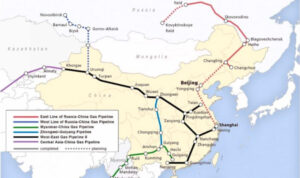Rui Feng
04/03/2024
In this recapitulation, China’s policies towards simultaneously achieving carbon neutrality and enhancing national energy security are reviewed. Without considering the vital energy safety, formulating climate policies toward carbon neutrality would be like a snow-covered Alp in a desolate desert.
Because China’s energy consumption has been greater than its domestic energy production in the recent decade, importing foreign energy safely and timely has become a top priority.
Thereby, China has deepened its connection with Russian, Iran, Pakistan, Myanmar, and Central Asian countries for energy cooperation, thus reshaping its roadmap towards CO2 emission reductions. Meanwhile, adjusting to strategical necessities and understanding future trends, China has proactively participated in the Arctic affairs to explore new resource frontier and sphere of influence.

Fig. 1. China’s main natural gas pipelines.
Also, China has boosted the developments of renewable energy, inclusive of wind, solar, hydro, nuclear, geothermal, and wave/tidal to rationalize energy structure and increase the capacity of energy production.
From 2009–2021, the cumulative installed electricity-generating capacity of renewable energy in China had increased from 874 to 2,374 million kW and the yearly power generation from 3,697 to 8,537 billion kWh.
With the enforcement of constructions of energy infrastructure under the framework of the Belt and Road Initiative (BRI), China has steadily promoted the internationalization of its currency, Renminbi (RMB).



